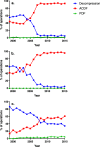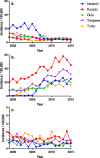Surgical techniques for degenerative cervical spine in Finland from 1999 to 2015
- PMID: 31401738
- PMCID: PMC6739280
- DOI: 10.1007/s00701-019-04026-9
Surgical techniques for degenerative cervical spine in Finland from 1999 to 2015
Abstract
Purpose: The purpose of this study is to assess the trends and regional variations in the operative techniques used for degenerative or rheumatoid cervical spine disease in Finland between 1999 and 2015.
Methods: The Finnish Hospital Discharge Register (FHDR) was searched for the data on all the primary operations for degenerative cervical spine disease (DCSD) or rheumatoid atlanto-axial subluxation (rAAS). Operative codes were used to identify the patients from the FHDR and combined with diagnosis codes to verify patient inclusion. The patients were classified into three groups: anterior cervical decompression and fusion (ACDF), posterior decompression and fusion (PDF) and decompression.
Results: A total of 19,701 primary operations were included. The adjusted incidence of ACDF rose from 6.5 to 27.3 operations/100,000 adults. ACDF became the favoured technique in all the diagnostic groups except AAS, and by 2015, ACDF comprised 84.5% of the operations. The incidence of PDF for DCSD increased from 0.2 to 0.7/100,000 people. Solely decompressive operations declined from 13.7 to 4.0 operations/100,000 people. The regional differences in the incidence of operations were most marked in the incidence of ACDF, with overall incidences ranging from 11.2 to 37.0 operations/100,000. The distribution of the operative techniques used varied as well.
Conclusions: Between 1999 and 2015, the operative techniques used for DCSD changed from prevalently decompressive to utilising ACDF in 68.8 to 91.0% of the operations, depending on the treating hospital. ACDF became the most commonly applied technique for all degenerative diagnoses except AAS.
Keywords: Degenerative cervical spine; Incidence; Nationwide register study; Operative techniques; Regional differences.
Conflict of interest statement
The authors declare that they have no conflicts of interest.
Figures





References
-
- Alosh H, Riley LH, 3rd, Skolasky RL (2009) Insurance status, geography, race, and ethnicity as predictors of anterior cervical spine surgery rates and in-hospital mortality: an examination of United States trends from 1992 to 2005. Spine (Phila Pa 1976) 34:1956–1962 - PubMed
-
- Anderson PA, Matz PG, Groff MW, Heary RF, Holly LT, Kaiser MG, Mummaneni PV, Ryken TC, Choudhri TF, Vresilovic EJ, Resnick DK, Joint Section on Disorders of the Spine and Peripheral Nerves of the American Association of Neurological Surgeons and Congress of Neurological Surgeons (2009) Laminectomy and fusion for the treatment of cervical degenerative myelopathy. J Neurosurg Spine 11:150–156 - PubMed
-
- Angevine PD, Arons RR, McCormick PC. National and regional rates and variation of cervical discectomy with and without anterior fusion, 1990-1999. Spine (Phila Pa 1976) 2003;28:931–940. - PubMed
-
- Bono CM, Ghiselli G, Gilbert TJ, Kreiner DS, Reitman C, Summers JT, Baisden JL, Easa J, Fernand R, Lamer T, Matz PG, Mazanec DJ, Resnick DK, Shaffer WO, Sharma AK, Timmons RB, Toton JF, North American Spine Society (2011) An evidence-based clinical guideline for the diagnosis and treatment of cervical radiculopathy from degenerative disorders. Spine J 11:64–72 - PubMed
-
- Boselie TF, Willems PC, van Mameren H, de Bie R, Benzel EC, van Santbrink H (2012) Arthroplasty versus fusion in single-level cervical degenerative disc disease. Cochrane Database Syst Rev (9):CD009173 - PubMed
Publication types
MeSH terms
Grants and funding
LinkOut - more resources
Full Text Sources
Medical

